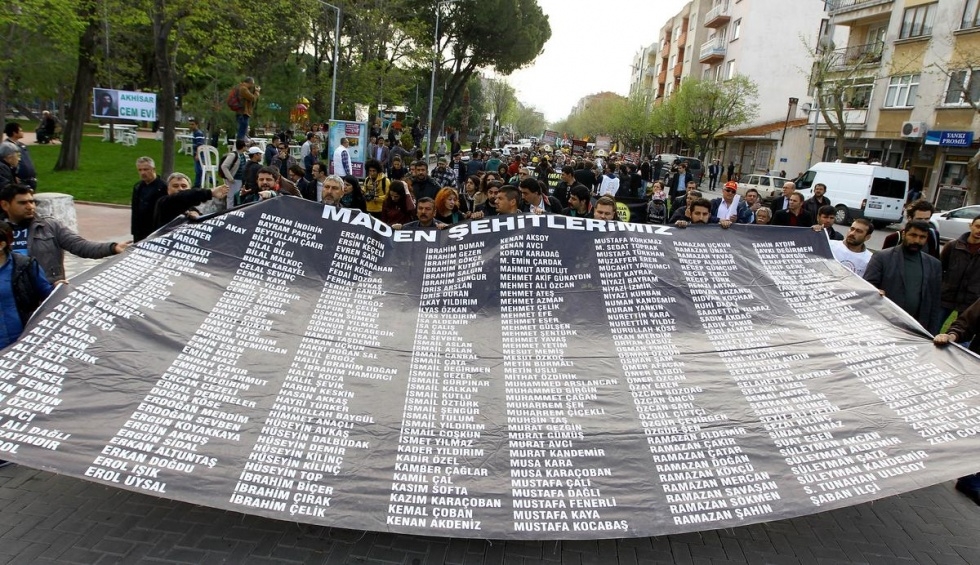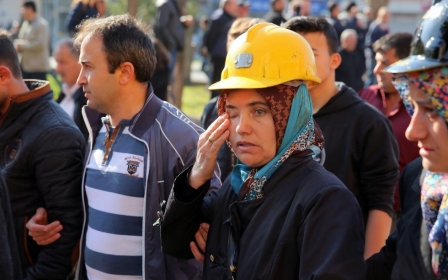ANALYSIS: Soma trial shows the blood price of Turkish coal

On the first day of the trial of the worst mining accident in Turkey that claimed the lives of 301 people in May 2014, national attention in the country is directed at Akhisar, Manisa. The small town, home to around 100,000 residents, is under the spotlight of national and international media coverage.
Relatives of the lost miners, a total of 487 people, filed 139 individual cases against the proprietor of the mine, Soma Mining Inc. Out of the 45 defendants, eight of them are currently in custody and charged with wilful homicide of 301 victims.
Last week, Akhisar Heavy Penal Court, the body that will hear the suit, announced that the defendants in custody will be joining the hearing through a video conference. This measure was taken to prevent a potential outburst of indignation that might harm the defendants in court.
"We do not want to see them [the defendants] as if we are watching a movie. We are not cannibals, we will not eat them." These words belong to Nursel Kocabas whose husband Mustafa was among the 301 victims.
"If their [the defendants] lives are valuable, what about ours? We only want them to look at our faces […] I want them to serve the longest sentence possible," she added.
Turkey's Union of Bar Associations president Metin Feyzioglu is among those following the hearing. Considering the mass protests that took place against the government officials after the incident last year, more than 1,000 personnel are expected to oversee the security measures in the town.
The disaster and aftermath
On 13 May 2014, an electrical malfunctioning of a transformer and the subsequent fire trapped workers inside the mine. While most of the miners died due to carbon monoxide poisoning, many of them were burned alive.
In terms of lost lives, Soma was the biggest mining accident in Turkey since the Zonguldak mining disaster of 1992, when 270 miners died. In addition to the death toll, surviving miners are still dealing with psychological difficulties.
Many of them are on anti-depressants to cope with the post-traumatic stress disorder and having difficulties in finding mining jobs in the aftermath of the disaster.
For Cigdem Yumbul, a project coordinator at the Union of Psychosocial Services in Emergencies (APHB), trauma, unemployment, trial processes and the upcoming anniversary of the disaster have a negative impact on the residents of Soma.
"People are reluctant to get psychological help because they fear that they will not be able to find jobs due to that," she observed. According to APHB figures, around 10,000 Soma residents faced hardships at various levels in the aftermath of the disaster.
Sadly, none of this suffering would have happened if preventable measures were in place. Allegations of serious negligence in safety conditions were directed at the company administration, but they were dismissed by the Soma Mining Inc officials.
A parliamentary commission was established to investigate the cause of the fire and published a report last December. The findings identified negligence on the company's part. However, rather than the inadequate safety measures, it was the mining regulations in Turkey that did not meet the international standards for safe mining.
Prior to the Soma accident, Turkey failed to sign the International Labour Organisation's (ILO) Safety and Health in Mines Convention of 1995. The document regulates various aspects of safety and health characteristics for work in mines, including inspections, and providing the workers with special working devices and protective equipment.
The convention also brings about regulations on monitoring workers' activities in the mines, and proper measures in emergency situations, especially the construction of rescue chambers.
It is safe to say that had the regulations met the ILO’s standards, a disaster at this scale could have been easily avoided. Turkey only signed the convention in December 2014, upon the publication of the commission investigation report.
Since 1941, more than 3,000 miners have been killed in similar accidents. In 2012 alone, 78 miners and in 2013, 95 miners died. A comparison with other countries illustrates the gravity of the situation.
According to Economic Policy Research Foundation of Turkey (TEPAV) research while only 1.27 people died in China per million tons of hard coal produced, the death rate is 7.22 persons in Turkey. The same figure is 0.02 in the United States.
Privatisation and mining methods
The scale of the disaster also has direct links to the methods of mining business in Turkey. Since the late 1980s the state issues private companies the authority to search and exploit underground natural resources in return of payments to the state.
Also known as "royalty payments"- which now occupies the highest percentage of mining activities in Turkey - this new business model leads private enterprises to reduce their costs in order to increase their profits.
The Soma Mining Inc, for instance, bought out the administration and exploitation rights of several mines from the Turkish Hard Coal Institute (TKK) in 2005 in return of royalty payments. It is currently the second largest coal producer in Turkey. Out of 5,500 of its personnel, 5,000 of them are currently miners.
In an interview in 2012, the chairman of Soma Mining Inc, Alp Gurkan, illustrated how private enterprises manage to lower operational costs and increase profitability of the mines. "[In Soma] the cost to produce one ton of coal was $130-140 for the TKK prior to privatisation. We guaranteed to lower the costs to $28.80 with a 15 percent royalty payment to the state," Gurkan noted.
In the interview, he further explained that they simply increased the efficiency of the mine, and he proudly compared the production methods of the private sector to those in public enterprises.
Increasing efficiency was one big development after the privatisation of the mine, but the means to achieve this is critical. In that sense, TEPAV research is self-evident: while the fatality rate is 11.5 people per one million ton of coal production in the private sector-run coal mines, it is 4.41 in the public administered mines.
According to Aziz Celik, a professor focusing on unionisation and social policies at Kocaeli University, the takeover of unprofitable mines by the private companies from the public sector has increased fatal mining accidents.
"For instance in the Zonguldak region, deadly accidents in private enterprises are 12 times more than the fully unionised public corporations," Celik told the Middle East Eye. "The idea of flexible working conditions in Turkey contributes to surging fatalities in the sector."
Trade unions and neoliberalism
The current outlook of the unionisation in Turkey appears to be significant: the death toll in workplace accidents and periodic safety inspections in mines appear to be linked to the strength and presence of the unions.
According to 2015 data, among the 12 million registered workers in Turkey, only 1.2 million of them possess a membership of a trade union. This is the lowest rate in the Organisation for Economic Co-operation and Development (OECD) with around 9.3 percent.
The situation is even worse when unregistered workers are considered. The Ministry of Labour and Social Security only takes registered workers into account, overlooking the real numbers.
Over the last 15 years, the proportion of workers with collective bargaining rights fell drastically in Turkey, and according to OECD 2012 data, the real unionisation rate is around 4.5 percent.
Although there is a decreasing trend in unionisation in the OECD countries at large, the decline is happening at a faster rate in Turkey with the increasing number of subcontractors and privatisation initiatives of the government.
According to Gamze Yucesan-Ozdemir, a professor focusing on social and labour policies in Turkey, there is a direct link between the Justice and Development Party (AKP) government's neoliberal policies and reorganisation of the modes of production.
In her work titled Social Policy Regime in the AKP Years, she argues that the government's policy preferences resulted in a surge of insecure working conditions.
"Social policies in Turkey boosted informal work and de-unionisation, hence resulting in job insecurity," Yucesan-Ozdemir argued. "Irregularities and subcontracting methods have become widespread, paving the way to the increasing presence of subcontractors and temporary work. This situation had a negative impact on the wages and rights of the workers in the formal sector."
The flexibility in the labour market consequently affects the safety conditions in different businesses. And for Aziz Celik, the administration of high risk industries such as mining should be returned to the total control of public enterprises.
"Insecure working conditions and subcontracting in the public sector should come to an end," Celik argued. "This is the most effective way to reduce fatalities."
By signing the ILO convention and with other measures, the government is making efforts to improve the mining conditions, but a return to full-scale public ownership in mining industries in Turkey remains as a distant option in the foreseeable future.
New MEE newsletter: Jerusalem Dispatch
Sign up to get the latest insights and analysis on Israel-Palestine, alongside Turkey Unpacked and other MEE newsletters
Middle East Eye delivers independent and unrivalled coverage and analysis of the Middle East, North Africa and beyond. To learn more about republishing this content and the associated fees, please fill out this form. More about MEE can be found here.




